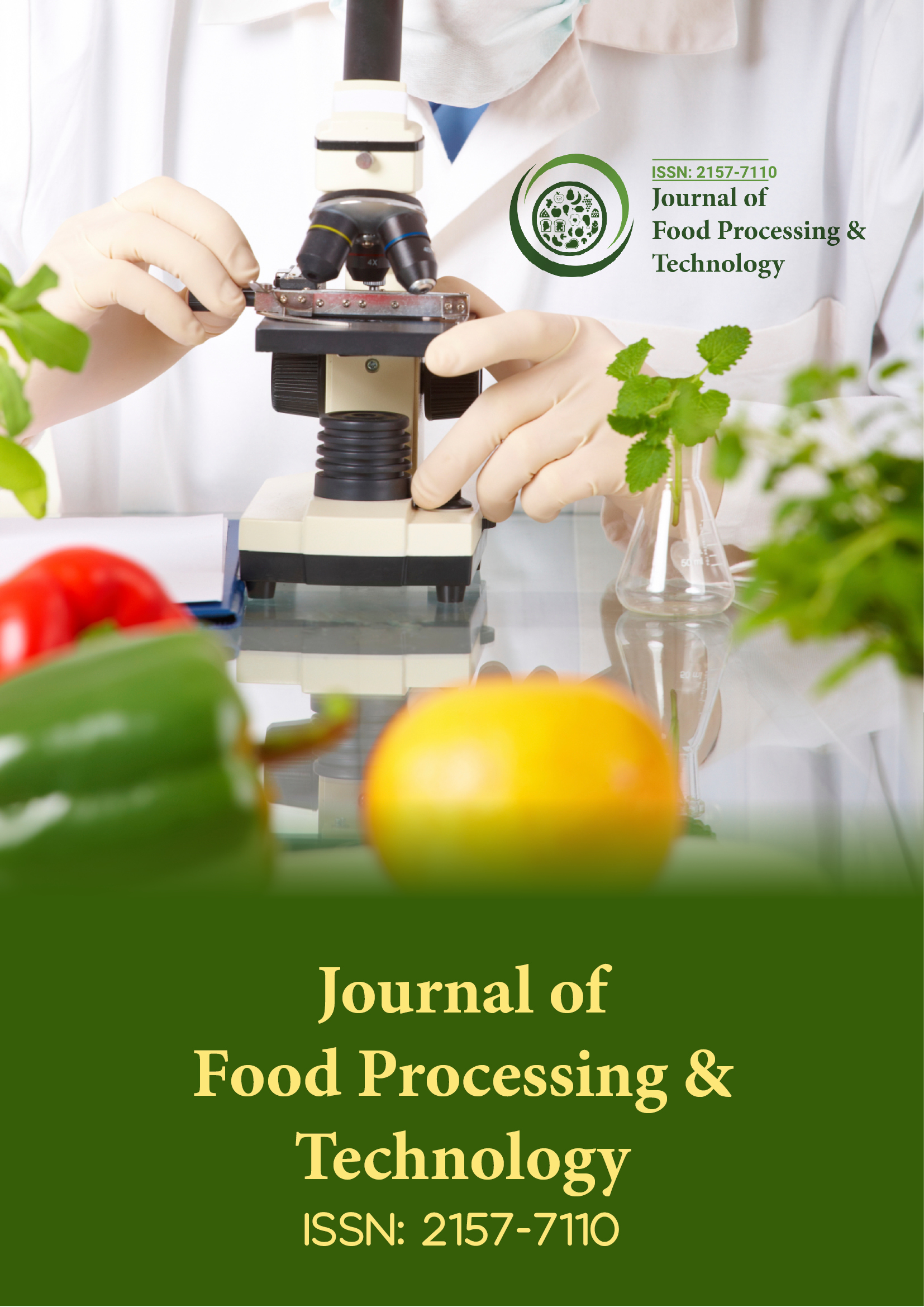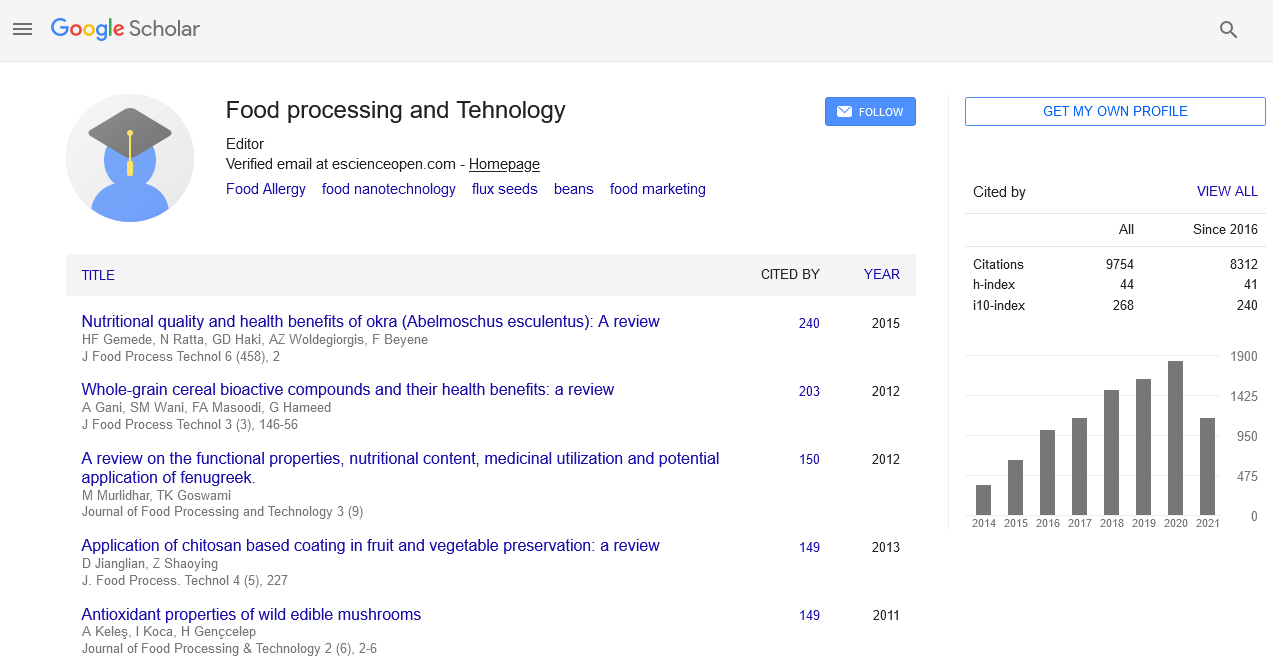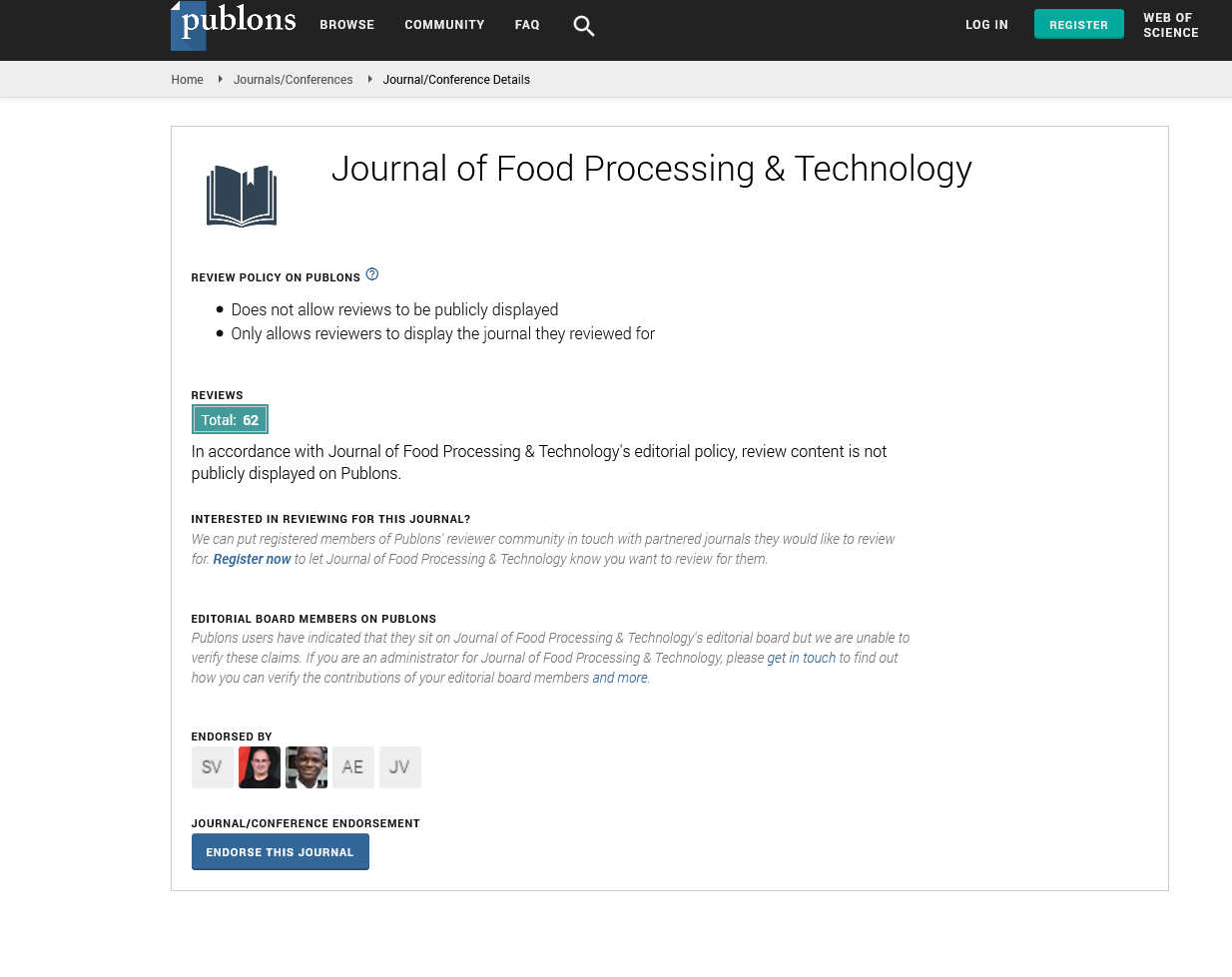Indexed In
- Genamics JournalSeek
- Academic Keys
- JournalTOCs
- China National Knowledge Infrastructure (CNKI)
- Access to Global Online Research in Agriculture (AGORA)
- Centre for Agriculture and Biosciences International (CABI)
- RefSeek
- Directory of Research Journal Indexing (DRJI)
- Hamdard University
- EBSCO A-Z
- OCLC- WorldCat
- Scholarsteer
- SWB online catalog
- Publons
- Euro Pub
- Google Scholar
Useful Links
Share This Page
Journal Flyer

Open Access Journals
- Agri and Aquaculture
- Biochemistry
- Bioinformatics & Systems Biology
- Business & Management
- Chemistry
- Clinical Sciences
- Engineering
- Food & Nutrition
- General Science
- Genetics & Molecular Biology
- Immunology & Microbiology
- Medical Sciences
- Neuroscience & Psychology
- Nursing & Health Care
- Pharmaceutical Sciences
Short Communication - (2025) Volume 16, Issue 2
Advancements in Thermal Processing for Retaining Nutritional Quality in Fruits
Emily Johnson*Received: 28-Mar-2025, Manuscript No. JFPT-25-29634; Editor assigned: 31-Mar-2025, Pre QC No. JFPT-25-29634; Reviewed: 14-Apr-2025, QC No. JFPT-25-29634; Revised: 22-Apr-2025, Manuscript No. JFPT-25-29634; Published: 28-Apr-2025, DOI: 10.35248/2157-7110.25.16.1148
Description
Food preservation techniques have always been central to ensuring the stability, safety and availability of perishable commodities. Among these, thermal processing has stood as one of the longest and most trusted methods in the food industry. From ancient boiling and cooking practices to the highly controlled industrial heating systems of today, the principle has remained the same using heat to inactivate harmful microorganisms and extend shelf life. Over time, however, the focus has shifted. Modern research does not only aim to secure food safety but also seeks to maintain the nutritional, sensory and functional qualities of fruit-based products, which are often compromised by prolonged or uneven heating [1].
Traditional heating methods, such as conventional pasteurization or sterilization, while effective in destroying pathogens, often resulted in the degradation of heat-sensitive nutrients, particularly vitamins, as well as volatile aromatic compounds. This degradation reduced both the nutritional density and the sensory profile of products such as juices, nectars and fruit purées. Vitamins like vitamin C are especially susceptible, with losses occurring even at relatively moderate heat exposure. Moreover, prolonged heating was known to dull natural color pigments and alter the fresh aroma profile, leading to consumer dissatisfaction [2].
To address these concerns, the food industry has turned toward refining thermal processing by introducing more precise and efficient methods. A growing emphasis has been placed on controlling not only the temperature but also the duration and uniformity of heat application. Modern heating technologies such as ohmic heating, microwave heating and infrared systems have shown significant promise. These advanced systems allow energy to be distributed more uniformly throughout the product, thereby reducing localized overheating that is responsible for nutrient and sensory damage. For instance, ohmic heating uses electrical resistance within the product itself to generate heat, resulting in very rapid and uniform temperature rises. Similarly, infrared and microwave systems enable shorter processing times, minimizing nutrient loss while still ensuring microbial safety [3].
A particularly critical area of focus in fruit processing remains the retention of vitamin C, a key antioxidant and marker of freshness, which is highly heat-sensitive. Researchers are working to optimize conditions where microbial inactivation can be achieved with minimal temperature exposure. Rapid heating and cooling cycles, as applied in flash pasteurization, have been shown to preserve higher levels of vitamin C and other antioxidants compared to traditional pasteurization. In addition to vitamins, color stability and aroma compounds—essential to consumer perception of “freshness” are also better preserved using these rapid processes. Flash pasteurization, for example, has proven especially successful in extending the shelf life of fresh juices while maintaining much of their original flavor and brightness [4].
Another frontier in this field is the integration of predictive modeling and digital technologies in processing plants. Computational models now allow industries to simulate various thermal treatment scenarios before actual implementation. By predicting how a product will respond under different heating conditions, manufacturers can fine-tune processing parameters with greater precision, reducing reliance on costly trial-and-error experimentation. Real-time sensors are also being embedded into industrial equipment to continuously monitor internal product temperatures, ensuring that heat treatment is applied consistently and evenly. This combination of predictive modeling with real-time monitoring represents a significant advancement in guaranteeing both safety and quality [5].
Beyond technical considerations, consumer preferences have also driven innovation. Globally, there has been an increasing demand for minimally processed foods that convey an image of naturalness and freshness. Fruit products that better retain their natural bioactive compounds, such as polyphenols and flavonoids, are perceived as healthier and more appealing. These compounds contribute not only to antioxidant activity but also to the sensory richness of fruits. Advanced thermal processing techniques, by minimizing nutrient loss, help manufacturers meet this demand for high-quality, “fresh-like” products [6].
Economic and sustainability dimensions further reinforce the importance of improved thermal processing. Higher nutrient retention results in products with added market value, as they can be positioned as premium offerings that appeal to healthconscious consumers. Moreover, energy-efficient technologies such as ohmic heating reduce energy consumption, aligning industrial practices with global sustainability goals. In highly competitive international markets, particularly in Europe and Asia, industries adopting these advanced methods are gaining a significant edge by delivering superior products while lowering production costs [7].
Nevertheless, significant challenges remain. Scaling advanced technologies from laboratory research to full-scale industrial operations is not always straightforward. Each fruit variety presents unique challenges due to differences in texture, sugar content, pH and moisture distribution, all of which influence heat transfer dynamics. For example, the thermal requirements for processing mango purée differ considerably from those for apple juice, meaning that protocols must often be customized. Additionally, the cost of installing advanced heating systems and integrating digital monitoring tools can be a barrier for small and medium-sized enterprises [8].
Looking forward, continued interdisciplinary research will be essential to refining heating protocols for a wider range of fruit products. Collaborations between food scientists, engineers and industry stakeholders will likely accelerate the adoption of advanced thermal methods. The integration of thermal processing with digital technologies, artificial intelligence and automation holds great promise for the future. Such systems could enable real-time adjustments to processing conditions based on predictive algorithms, ensuring that every batch of fruit products achieves optimal safety, nutrition and sensory quality [9].
In conclusion, thermal processing remains indispensable in the preservation of fruit products, but its role is rapidly evolving. No longer limited to basic microbial inactivation, it is now a sophisticated tool for balancing safety with nutrition and sensory appeal. As advanced technologies continue to develop and scale, consumers will gain access to fruit products that more closely resemble fresh harvests in taste, color and health benefits. At the same time, industries will benefit from enhanced shelf stability, market competitiveness and sustainable production practices. The future of fruit processing lies in this delicate balance harnessing the protective power of heat while preserving the natural goodness that consumers increasingly demand [10].
References
- Lv M, Liu Y, Geng JH, Kou XH, Xin ZH, Yang DY. Engineering nanomaterials-based biosensors for food safety detection. Biosens Bioelectron. 2018;106:122–128.
[Crossref] [Google Scholar] [PubMed]
- Lomeli-Martin A, Martínez LM, Welti-Chanes J, Escobedo-Avellaneda Z. Induced Changes in Aroma Compounds of Foods Treated with High Hydrostatic Pressure: A Review. Foods. 2021;10:878.
[Crossref] [Google Scholar] [PubMed]
- Huang H, Chen B, Wang C. Comparison of high pressure and high temperature short time processing on quality of carambola juice during cold storage. J Food Sci Technol. 2018;55:1716–1725.
[Crossref] [Google Scholar] [PubMed]
- Margosch D, Ehrmann MA, Buckow R, Heinz V, Vogel RF, Gänzle MG. High-Pressure-Mediated Survival of Clostridium botulinum and Bacillus amyloliquefaciens Endospores at High Temperature. Appl Environ Microbiol. 2006;72:3476–3481.
[Crossref] [Google Scholar] [PubMed]
- Koseki S, Yamamoto K. Modelling the Bacterial Survival/Death Interface Induced by High Pressure Processing. Int J Food Microbiol. 2007;116:136–143.
[Crossref] [Google Scholar] [PubMed]
- Chien SY, Sheen S, Sommers CH, Sheen LY. Modeling the Inactivation of Intestinal Pathogenic Escherichia coli O157:H7 and Uropathogenic E. coli in Ground Chicken by High Pressure Processing and Thymol. Front Microbiol. 2016;7:920.
[Crossref] [Google Scholar] [PubMed]
- Donsì G, Ferrari G, Maresca P. Pasteurization of Fruit Juices by Means of a Pulsed High Pressure Process. J Food Sci. 2010;75:169–177.
[Crossref] [Google Scholar] [PubMed]
- Luu S, Cruz-Mora J, Setlow B, Feeherry FE, Doona CJ, Setlow P. The Effects of Heat Activation on Bacillus Spore Germination, with Nutrients or under High Pressure, with or without Various Germination Proteins. Appl Environ Microbiol. 2015;81:2927–2938.
[Crossref] [Google Scholar] [PubMed]
- Chung YK, Yousef AE. Inactivation of barotolerant strains of Listeria monocytogenes and Escherichia coli O157: H7 by ultra-high pressure and tert-butylhydroquinone combination. J Microbiol. 2008;46(3):289-294.
[Crossref] [Google Scholar] [PubMed]
- Yang P, Rao L, Zhao L, Wu X, Wang Y, Liao X. High Pressure Processing Combined with Selected Hurdles: Enhancement in the Inactivation of Vegetative Microorganisms. Compr Rev Food Sci Food Saf. 2021;20:1800–1828.
[Crossref] [Google Scholar] [PubMed]
Citation: Johnson E (2025). Advancements in Thermal Processing for Retaining Nutritional Quality in Fruits. J Food Process Technol.16: 1148.
Copyright: © 2025 Johnson E. This is an open access article distributed under the terms of the Creative Commons Attribution License, which permits unrestricted use, distribution and reproduction in any medium, provided the original author and source are credited.


